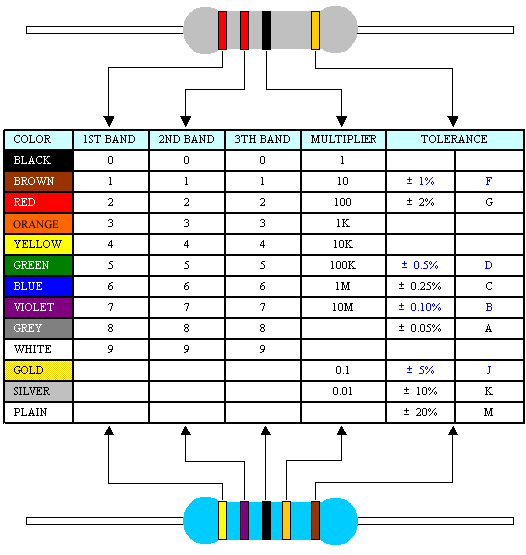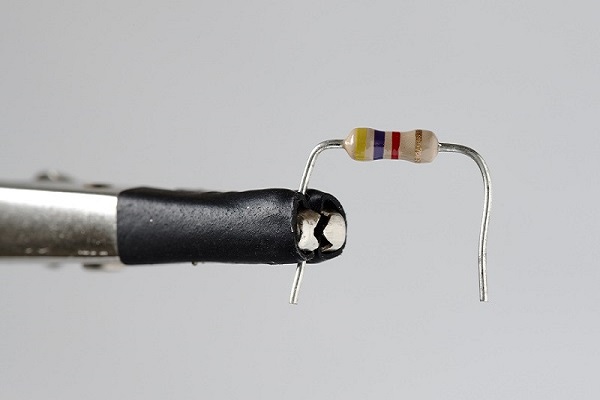What is a Resistor?
A Resistor is an electrical component that reflects electrical resistance to the circuit current. It is a passive Element which means it only absorbs the electrical power. It cannot deliver power to the circuit connected with this element. Here we are discussing the Resistor definition, unit, symbol, types, color code, and applications.
Table of Contents
A resistor has two terminals. And there is a Nichrome wire inside, which is wound on a ceramic base. The outer covering has a painting on it, to protect it from environmental conditions. The length of the Nichrome wire depends upon the resistance.
Unit of the Resistor
The unit of Resistance is Ohm (Ω). It was named after “Georg Simon Ohm”. Which is pronounced as “Ohm”. Also, it may be represented by Volts/Ampere.
Symbol of the Resistor
There are two types of Resistor symbols to represent:
What is a resistor Color Code
A resistor has color code bands on it instead of having Ohmic ratings on it. Furthermore, we have some surface-mounted resistors on the PCBs (printed circuit boards). These types of resistors have numbers on them instead of color code bands.
This is the color code table for resistors:
| Color | Code |
|---|---|
| Black | 0 |
| Brown | 1 |
| Red | 2 |
| Orange | 3 |
| Yellow | 4 |
| Green | 5 |
| Blue | 6 |
| Violet | 7 |
| Grey | 8 |
| White | 9 |

What is the tolerance of the Resistor?
Tolerance tells the reliability of the resistor means how much the Ohmic value may differ. This difference may occur due to the temperature or fabrication. This is the last color mentioned always.
Tolerance corresponding to the color code is in the table below:
| Color | Tolerance |
|---|---|
| Brown | ±1% |
| Red | ±2% |
| Gold | ±5% |
| Silver | ±10% |
Also, there is no polarity given on any of these. So they can be used in both AC as well as in DC networks/circuits. It is combined with the circuit in two ways. One is a SERIES combination another is a PARALLEL combination.
Resistor Types
There are two basic types of resistors:
- Linear resistor.
- Non-Linear resistors.
1. Linear Resistor Types
A Linear resistor has a linear “Voltage versus current” graph on any load. These are further divided into two types.
Fixed resistor- These have a fixed resistance value and do not change in any condition. Their resistance is decided by fabrication time only. These are the following groups of resistors.
- Carbon composition resistors.
- Wire wound resistors.
- Thin-film resistors.
- Thick film resistors.
Variable resistors- These have variable resistance and their resistance is decided by the user. A rotating knob decides the Resistance. They have the following groups of resistors.
- Potentiometers.
- Rheostats.
- Trimmers.
Non-Linear Resistor Types
Non-linear resistors have a nonlinear graph of Voltage versus current. So it means it does not obey Ohm’s Law. The following are Non-linear resistor types.
- Thermisters.
- Varistors.
- Photoresistors.
Combinations:
- Parallel combination.
- Series combination.
1. Series combination
A series connection of resistors means adding them serially one after another. The total resistance of the combination can be found by the equation.
R = R_1 + R_2
Suppose we have two resistors having 5Ω and 3Ω resistors connected in series. By the above formula resistance of the total combination will be R=3+5=8Ω.
2. Parallel combination
Resistors can be combined with themselves in Parallel connection, By adding both of their terminals respectively connected to each terminal of the other. Then the total resistance of the combination circuit can be found by the equation.
\frac{1}{R_{eq}} = \frac{1}{R_{1}} + \frac{1}{R_{2}}Suppose we have two resistors having 5Ω and 3Ω resistors connected in parallel. By the above formula resistance of the total combination will be :
\frac{1}{R_{eq}} = \frac{1}{5}+ \frac{1}{3}R_{eq} = \frac{15}{5+3} = \frac{15}{8} = 1.875Here, we got-
Series: 8Ω
Parallel: 1.875Ω
Hence we can conclude that the resistance of the series connection is higher than the parallel connection. Here are some applications for it.
Resistor Applications
Following are the Resistor applications.
- The resistor has the application of the temperature control device.
- Photo Resistors are used in alarm systems, flame detectors, cameras, etc.
- Also, they are used in modulators, demodulators, etc.
- Every electronic device needs a voltage drop.
